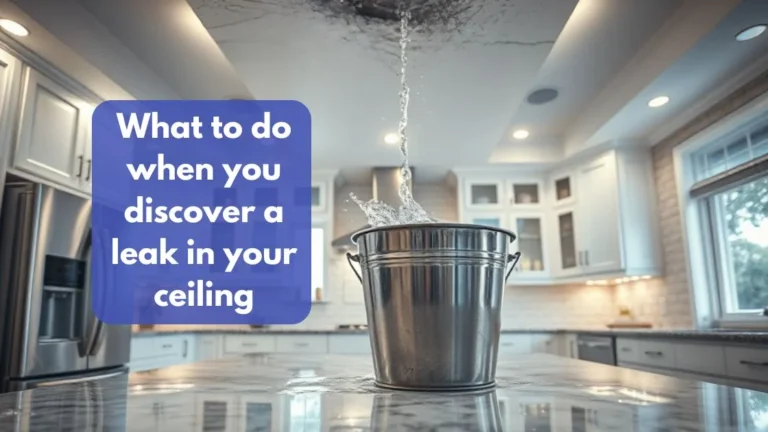When you discover a leak in your ceiling, act swiftly to minimise damage.
Initially, identify the source of the leak by inspecting wet areas and documenting any signs such as stains or sagging.
Next, contain the water by placing a bucket underneath and moving furniture out of the way.
Turn off the water supply to stop further leakage.
Seek professional assistance for a thorough assessment and repairs, particularly if necessary to avoid escalating costs.
Lastly, assess the damage and document everything for insurance purposes.
Taking these immediate steps is essential for effective resolution and protection of your property.
Identify the Leak Source
Identifying the source of a ceiling leak is essential for effective remediation and preventing further damage. Begin by placing a bucket under the leak to contain dripping water, thereby protecting your flooring.
Conduct a plumbing inspection to determine if the leak originates from plumbing or roof-related issues; plumbing leaks can occur regardless of weather, while roof leaks typically present themselves during rainfall.
Inspect the loft or attic for damp insulation or moisture, marking these areas for a thorough roof assessment. Look for visible signs such as water stains or sagging ceilings, which can help pinpoint the leak’s origin. Check out these other tips on the actions to take after discovering a leak in your home.
Contain the Water
To effectively manage a ceiling leak, immediate containment of water is essential in preventing further damage to your home.
Start by placing a bucket or container directly underneath the leak to catch dripping water, safeguarding your flooring and furnishings. Surround the collection container with towels or rags to absorb any overflow, regularly emptying it to prevent spillage. If the leak is substantial, consider using multiple containers as effective drainage solutions.
Furthermore, move any furniture or valuables away from the affected area to protect them from water damage. Vigilantly monitor the leak and be prepared to adjust your containment strategy as necessary, especially if the leak worsens or water begins to pool elsewhere, ensuring proactive leak prevention throughout the process.
Turn Off Water Supply
When faced with a ceiling leak, swiftly turning off the water supply is essential to prevent further damage. Locate the main shut-off valve, which is typically found in basements, kitchens, or near toilets. To stop the flow, turn the valve clockwise. This critical valve operation halts water throughout the entire house, protecting your space from additional leaks.
If the source of the leak is unclear, shutting off the main supply is crucial to mitigate flooding risks. Inform all residents about the shut-off, as it will disrupt water access to all fixtures.
| Action | Location Type | Valve Operation |
|---|---|---|
| Identify shut-off location | Basement | Turn clockwise |
| Inform household members | Kitchen | Guarantee awareness |
| Stop water flow | Near toilets | Prevent further damage |
| Assess repair needs | Any affected area | Evaluate situation |
After taking these steps, assess whether professional assistance is necessary for repairs.
Seek Professional Assistance
Timely action is essential when addressing a ceiling leak, as delays can exacerbate damage and increase repair costs.
Selecting the right expert—whether a leak detection service, licensed plumber, or qualified roofer—ensures that the issue is accurately diagnosed and effectively resolved.
Engaging professionals not only mitigates immediate risks but also provides long-term peace of mind through their expertise and warranties. Learn More: Questions to ask during leak emergencies.
Importance of Timely Action
Addressing a ceiling leak with urgency is crucial to mitigating potential damage and associated costs. Timely action allows homeowners to implement preventive maintenance strategies, ultimately safeguarding their property.
Repair costs for water damage can escalate to thousands of pounds, reinforcing the necessity of immediate intervention. Moreover, mould can proliferate within 24 to 48 hours of water exposure, posing health risks and complicating repairs.
Seeking professional assistance guarantees accurate identification of the leak’s source, reducing the likelihood of recurring issues. In addition, insurance providers often require expert evaluations for claims, making prompt professional help indispensable for securing coverage.
Documenting the leak while coordinating with professionals not only strengthens insurance claims but also enhances emergency preparedness, providing peace of mind for you and your family.
Choosing the Right Expert
Identifying the right expert to address a ceiling leak is essential for effective resolution and prevention of further damage.
To begin, determine whether the source of the leak is plumbing or roofing, as this will guide you in deciding between a plumber and a roofer. For significant leaks, seek immediate professional assistance to mitigate structural issues and prevent escalating repair costs.
Make use of local resources or online platforms to find vetted leak detection professionals, ensuring they possess the necessary qualifications and experience. Document any damage and relevant details prior to contacting an expert to facilitate a thorough assessment and repair process.
Furthermore, consult your insurance provider for recommendations, as they may have preferred contractors and insights into coverage for necessary repairs.
Assess and Document Damage
To effectively address a ceiling leak, begin by identifying visible damage, such as stains and sagging, to gauge the leak’s severity.
Capturing detailed photographic evidence alongside notes about the leak’s source is essential for future assessments and insurance claims.
This thorough documentation not only aids in understanding the problem but also prepares you for the necessary professional interventions.
Related: How to make a claim for water damage on your home insurance.
Identify Visible Damage
When faced with a ceiling leak, the initial step is to thoroughly inspect the area for visible signs of damage. Look for water stains, discolouration, and sagging, as these indicators reveal the severity of the leak.
Use a torch to examine the surrounding area for cracks or holes that might allow water intrusion, prioritising water safety in your assessment. Note any peeling paint or blistering, which can suggest prolonged water exposure.
Documenting these details is essential for effective leak prevention strategies and future repairs. Keep a detailed record of the date and time you identified the leak and observations about moisture levels.
This comprehensive approach fosters a sense of community and belonging as you share insights from shared experiences in home maintenance.
Take Photographic Evidence
Capturing photographic evidence of the ceiling leak is vital for a thorough assessment and effective documentation of the damage.
Employing various photographic techniques, take clear, detailed images of the leak and surrounding areas, including walls and floors. This multi-angle approach not only provides a comprehensive view but also aids in damage assessment for insurance claims or professional evaluations.
Close-ups of stains, bulges, or mould growth will underscore the severity of the situation and potential health risks. Ensure that timestamps are visible to establish when the damage was discovered, a crucial aspect for documentation.
Organising and labelling the photos clearly will facilitate communication with insurance providers or contractors, confirming that you are well-prepared to address the necessary repairs.
Note Leak Source
Identifying the source of a ceiling leak is essential for effective mitigation and repair. Employing leak identification techniques such as inspecting for water stains or sagging can help pinpoint whether plumbing or roofing issues are at fault.
Focus on wet areas beneath bathrooms or kitchens to assess potential plumbing leaks, while noting that roofing leaks often intensify during rainfall. Document every detail, including photographs and notes about changes in the ceiling’s condition, such as discolouration or bulging, as this information is vital for insurance claims and professional assessments.
If water accumulation is significant, consider creating a small drainage hole to prevent further structural damage while you investigate. Proper documentation not only aids repairs but fosters a sense of community support in addressing home challenges.
Plan for Repairs and Restoration
A well-structured plan for repairs and restoration is essential after dealing with a ceiling leak.
Begin by evaluating the extent of water damage to determine whether you can employ simple repair techniques or if professional restoration options are necessary.
Thoroughly dry all affected areas using specialist equipment like dehumidifiers and fans to prevent mould growth and further structural issues.
For significant damage, it is prudent to consult restoration experts who can offer tailored solutions, including mould remediation and insulation replacement.
Document all repairs meticulously; this not only aids in the restoration process but also streamlines insurance claims, ensuring you receive timely reimbursement.
Taking these steps fosters a sense of community and security in your living space.
Key Takeaways
- Identify the source of the leak by inspecting plumbing, roofs, and visible signs of water damage, documenting your findings with photographs and notes.
- Contain the water by placing a bucket underneath the leak and moving valuables away to prevent damage.
- Turn off the main water supply to stop further leakage and inform all residents about the disruption.
- Seek professional assistance, such as a plumber or roofer, to accurately diagnose and repair the leak.
- Assess and document the damage with photographs and written notes for insurance claims and professional evaluations.
Have you noticed water stains or damp patches forming on your ceiling?
A water leak in your ceiling can lead to major structural damage and costly repairs if not addressed promptly!
What if you could fix that ceiling leak quickly and effectively without the hassle and stress? Our specialised water leak ceiling repair service in Northern Ireland is designed to tackle leaks efficiently, restoring your home to its best condition.
Imagine your home free from unsightly water stains, mould, and the threat of structural damage. With our expert service, you can ensure your ceiling is repaired professionally, giving you peace of mind and protecting your investment.
Don’t wait for the problem to escalate. Contact us today to schedule your water leak ceiling repair service in Northern Ireland. Act now to safeguard your home and enjoy a leak-free ceiling once again!



